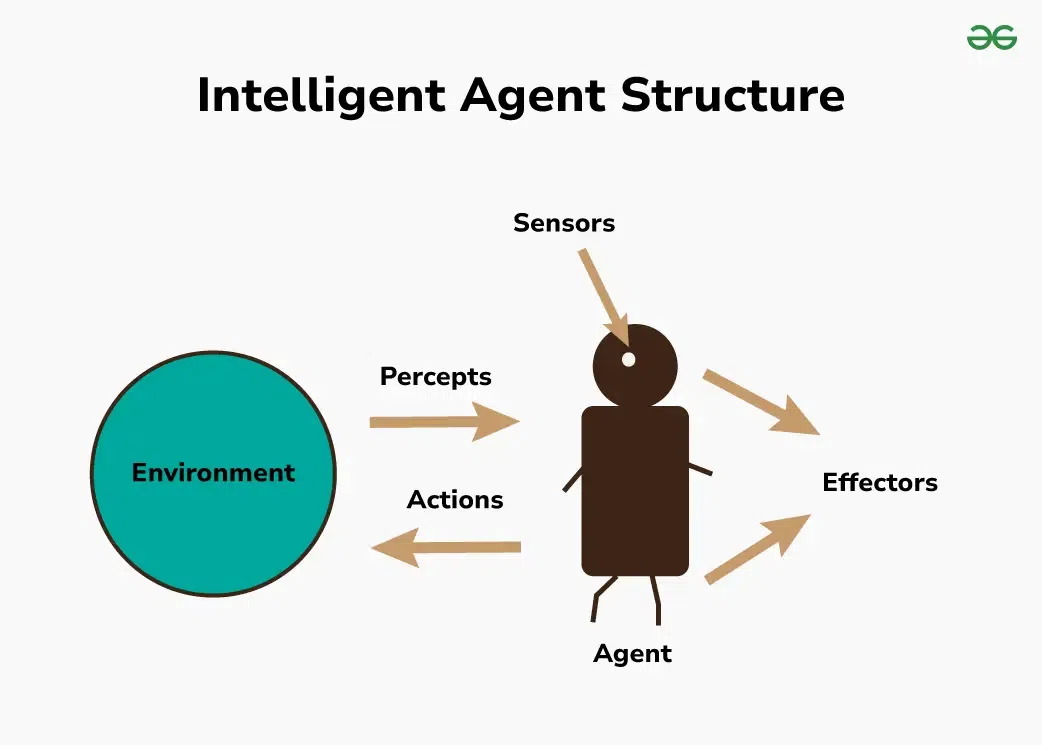Configuration of Agents, PEAS Description, and PAGE – A Complete Understanding of How Intelligent Agents Work

In our previous post, we explored the fundamentals of intelligent agents—what they are, how they work, and their different structures. We also examined the architecture of agents like reflex agents, goal-based agents, utility-based agents, and learning agents.
Now, we move one step further to understand how these agents are designed, how we define their tasks, and how we break down their capabilities using the PEAS framework and PAGE model.
Part 1: Configuration of Intelligent Agents
What is Configuration?
The configuration of an intelligent agent refers to how its components are organized and structured to function effectively in a specific environment. This includes how it perceives, thinks, and acts based on its goals and surroundings.
Key Configuration Components
| Component | Role |
|---|
| Perception System | Collects data from the environment |
| Knowledge Base | Stores facts, models, and learned information |
| Decision-Making Unit | Determines actions based on goals or rules |
| Actuators/Action Unit | Carries out the chosen action |
| Learning Module | (Optional) Improves performance over time |
Architectures Based on Configuration:
- Simple Reflex Agents: Act based only on current percept.
- Model-Based Reflex Agents: Use internal model of the world.
- Goal-Based Agents: Use goals to choose among possible actions.
- Utility-Based Agents: Use utility functions to choose optimal actions.
- Learning Agents: Improve over time using feedback and learning.
Example: A robot vacuum cleaner can be a simple reflex agent (turn when it hits a wall) or a goal-based agent (map the room and clean efficiently).
Part 2: PEAS Description of Agents
To design an intelligent agent for a particular task, we use the PEAS framework. It helps us clearly define what an agent is supposed to do and how.
What Does PEAS Stand For?
- P – Performance Measure: How we evaluate success.
- E – Environment: Where the agent operates.
- A – Actuators: The tools the agent uses to affect the environment.
- S – Sensors: Devices used to perceive the environment.
This model helps design AI systems in a structured way.
Example 1: Self-Driving Car
| PEAS Element | Description |
|---|---|
| Performance Measure | Safety, fuel efficiency, reaching destination |
| Environment | Roads, traffic, pedestrians |
| Actuators | Steering, accelerator, brake |
| Sensors | Cameras, GPS, radar, LIDAR |
Example 2: Chess-Playing AI
| PEAS Element | Description |
|---|---|
| Performance Measure | Win the game |
| Environment | Chessboard, opponent |
| Actuators | Move chess pieces |
| Sensors | Board position, game rules |
Why PEAS Matters:
- Clarifies the design scope.
- Helps determine what sensors and actuators are needed.
- Defines what success looks like for the agent.
Part 3: PAGE – A Functional View of Agents
Another useful way to look at intelligent agents is the PAGE framework:
- P – Percepts: Inputs or observations from the environment.
- A – Actions: All possible moves the agent can take.
- G – Goals: Desirable end states or outcomes.
- E – Environment: The external context in which the agent operates.
PAGE in Action – Example: Email Spam Filter
| PAGE Element | Description |
|---|---|
| Percepts | Incoming email content, sender, subject line |
| Actions | Mark as spam, move to inbox, alert user |
| Goals | Minimize spam, maximize important emails shown |
| Environment | Email server, internet, user’s mailbox |
PAGE Example: Smart Traffic Light
| PAGE Element | Description |
|---|---|
| Percepts | Vehicle count, pedestrian buttons, timer |
| Actions | Change lights (green, yellow, red) |
| Goals | Reduce traffic congestion and waiting time |
| Environment | Road junction, cars, pedestrians |
The PAGE framework helps when you’re analyzing or explaining how an agent interacts with its world on a functional level.
Conclusion
In this post, we explored:
- How intelligent agents are configured based on their architecture and components.
- How PEAS helps in designing agents for real-world applications by defining their goals, environments, and tools.
- How PAGE offers a functional perspective, allowing us to analyze the behavior of agents in different contexts.
Understanding configuration, PEAS, and PAGE gives us the foundation to build smarter, more effective AI systems tailored to different tasks and environments.